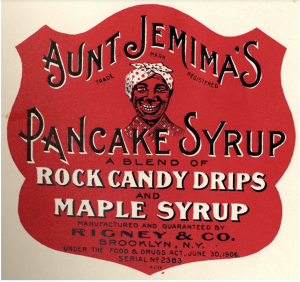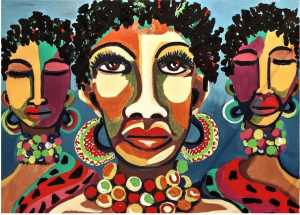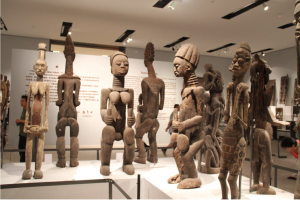Tschabalala Self: Making Representations of Yourself – Irene Faiz (OSSTF PD Day Feb 18 2022)
by Irene Faiz
Tschabalala Self: Making Representations of Yourself
Two Interviews – Two Representations
Media Construct versions of reality.
Pre-Viewing Activity
How is the Black female represented in our culture?
Is she represented at all?
Consider these representations of Aunt Jemima.
Original Label
Contemporary Label

Washington Post
Task:
Talk to a partner in the classroom or at home.
Make a list of the characteristics of the Black female as you see her represented in our culture.
Purpose Of This Activity:
Tschabalala Self is creating new representations of herself as a woman of colour. She is breaking the stereotypes about how women of colour have been represented in entertainment media and advertising.
Goal One:
In this activity you will compare and contrast the ways in which a female artist is represented in two interviews and in her own art.
Goal Two:
After completing this activity, you will interview two females.
You will ask them their thoughts about how Tschabalala Self is representing the Black female body.
The purpose of this activity is to ask females about their reaction to this art.
Not all reactions from the females you interview will be the same. It will be interesting to understand their various perspectives about these representations of the Black female body.
The interview questions are provided in Part Five.
Part One:
Listen to Tschabalala Self talk about her work being exhibited in an art show titled
The Beyond at the Crystal Bridges Museum of American Art from 2018.
In this video that runs for 1 minute and 33 seconds, Tschabalala Self explains her ideas about how she is representing the Black female body.
A. What materials is Self using to create these representations of the Black female body? (2 marks)
B. Why is she using these materials? (2 marks)
C. What is she asking us to consider about the Black female form? (2 marks)
Have a look at her work by clicking on this link.
The following images of Tschabala Self’s work are from her exhibit at the Fotene Demoulas Gallery in 2020.
Have a careful look at her work.
Answer the questions below.
Jan 20 – Jul 12, 2020
Fotene Demoulas Gallery
#TschabalalaSelf
Tschabalala Self (b. 1990, Harlem, New York) creates large-scale figurative paintings that integrate hand-printed and found textiles, drawing, printmaking, sewing, and collage techniques to tell stories of urban life, the body, and humanity. The artist’s first Boston presentation—and her largest exhibition to date—will include a selection of paintings and sculptures that represent personal avatars, couplings, and everyday social exchanges inspired by urban life. Together, they articulate new expressions of embodiment and humanity through the exaggerated forms and exuberant textures of the human figure, pointing to its limitless capacity to represent imagined states, memories, aspirations, and emotions. Yet Self’s characters possess an ordinary grace grounded in reality: they are reflections of the artist or people she can imagine meeting in Harlem, her hometown.
Curated by Ellen Tani and Ruth Ericsson
Image 1

Image 2
Out of Body

Image 3

Image 4
Ol’ Bay 
Image 5

Image 6

D. What subject matter is Tschabalala interested in as an artist? (2 marks)
E. How is she representing the female body? (2 marks)
F. In what ways might this representation of the female body be controversial?
Consider: Is it appropriate? Who might interpret it as porn? (2 marks)
G. How might this representation of the female body be justified artistically? (2 marks)
H. Compare and contrast Tschabalala Self’s representations of the female body with the following examples of African Art:
In what ways is Tschabalala’s representations of the female body similar and different from these examples of African art? (4 marks)
6. What materials is she working with? (2 marks)
7. Why might her work be important in the world today? (2 marks)
8. How are these images different from other representations of Black women you have seen? (4 marks)
9. Do an image search to find some contrasting images of Black women. (3 marks)
Insert three images here.
Part Two: First Interview
You will be watching two interviews with Tschabalala Self.
You will be comparing and contrasting these interviews.
Watch this interview
Tschabalala is being interviewed by two teenagers.
1. What do we learn about Tschabalala’s creative process?
2. Why might some people find Tschabalala’s art and artistic ideas inspiring?
Consider: What have you learned about her art and ideas by listening to this interview?
Consider: What do you find inspiring about Tschabalala as an artist? (2 marks)
3. Who is Tschabalala being interviewed by? (Be specific.) (2 marks)
4. What is their purpose in interviewing her? (2 marks)
5. How is Tschabalala being photographed for this interview?
Consider: Camera angle. Lighting. Distance. (3 marks)
6. How is Tschabalala dressed for this interview? What message might her clothing communicate to the audience? (2 marks)
7. What music is being played to introduce this interview? (2 marks)
8. What message does this music communicate to you? Explain how? (2 marks)
Part Three: Second Interview
This is the second interview you will be watching with Tschabalala Self.
You will be comparing and contrasting these interviews.
Watch this interview.
Tschabalala is being interviewed about a collection of art that she created over a period of five years or less. This exhibit is probably her first solo exhibition.
Tschabalala is being interviewed by the curator of her solo exhibition.
1. What do we learn about Tschabalala’s creative process?
2. Why might some people find Tschabalala’s art and artistic ideas inspiring?
Consider: What have you learned about her art and ideas by listening to this interview?
Consider: What do you find inspiring about Tschabalala as an artist? (2 marks)
3. Who is Tschabalala being interviewed by? (Be specific.) (2 marks)
4. What is their purpose in interviewing her? (2 marks)
5. How is Tschabalala being photographed for this interview?
Consider: Camera angle. Lighting. Distance. (3 marks)
6. How is Tschabalala dressed for this interview? What message might her clothing communicate to the audience? (2 marks)
7. What music is being played to introduce this interview? (2 marks)
8. What message does this music communicate to you? Explain how? (2 marks)
Consider: What have you learned about her art and ideas by listening to this interview?
Consider: What do you find inspiring about Tschabalala as an artist? (2 marks)
Part 4. Tschabalala Self’s Art Assignment
Sarah Urist Green’s recent book, You Are An Artist, features more than 50 contemporary artists. Each of these artists is giving us inspiration for an art assignment that they have designed for us to create during this pandemic.
Watch this video featuring Sarah Urist Green, the author, and Tschabalala Self, the artist.
Here are the instructions from Tschabalala Self:
1. If you were a shape, what shape would you be?
2. Make a line drawing of a shape that you think represents yourself?
(Try to avoid known shapes.)
3. Fill this object with colour or pattern or some combination thereof.
Make four idea drawings to start this art assignment.
Part Five:
Interview Two Females
You may interview two girls in our class.
You may interview family members or other females that you know.
Show them three artworks by Tschabalala Self. You may show them any representations of the Black female form that Tschabalala has created.



Ask them the following questions:
Interview #1
Who did you interview?
Age?
1. Do you like these representations of the female body?
2. Why or why not?
(2 marks)
3. What do you think these representations are saying about the Black female body?
(2 marks)
Interview #2
Who did you interview?
Age?
1. Do you like these representations of the female body?
2. Why or why not?
(2 marks)
3. What do you think these representations are saying about the Black female body?
(2 marks)
Total Marks: / 81






